AWS CEO Adam Selipsky Tells Partners At re ‘Be Experts, Be Trained, Be Certified’
‘When we have partners with real experts who show up at our customer sites, we hear all about it. And it‘s just incredibly important for maintaining that trust,’ said AWS CEO Adam Selipsky at AWS’ re:Invent conference.
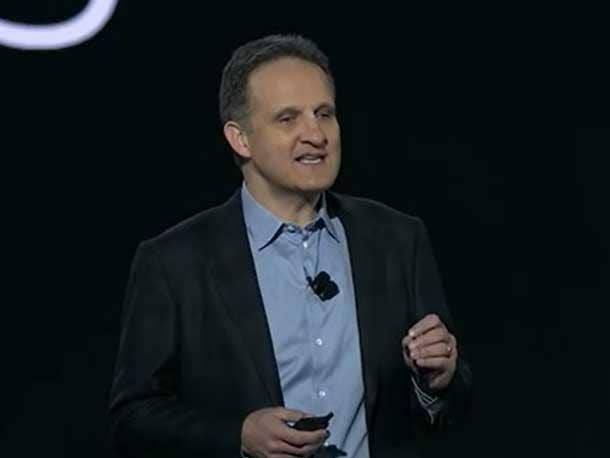
In his first appearance at Amazon Web Services’ cloud computing-focused re:Invent conference with the title of AWS CEO, Adam Selipsky made several appearances throughout the event to make product announcements and tell attendees that cloud adoption is still in its earliest days even 15 years after AWS formed.
The event—held in person in Las Vegas and online due to the global pandemic—gave Selipsky the chance to participate in a question-and-answer session with outgoing AWS Channel Chief Doug Yeum during AWS’ Global Partner Summit, deliver a keynote address during the main event and host a question-and-answer session with members of the press to discuss a new solution made in collaboration with bank Goldman Sachs, the GS Financial Cloud for Data.
“I’d say the easiest prediction to make is that 10 years from now, the partner ecosystem and investment in the ecosystem is still going to be an incredibly central part of the AWS strategy,” Selipsky said during his talk with Yeum, who is set to leave AWS to work for the retail division of parent company Amazon.com.
[RELATED: Outgoing AWS Channel Chief Doug Yeum: ‘We Have Been Putting More Focus On Engaging Partners’]
He continued: “We’re all just getting going, and I can’t imagine customers being happy with anything except deep, tight partnerships across technology providers, ISVs, systems integrators, consultants, resellers, distributors and VARs. We’re going to continue to invest in all those areas.”
Selipsky—who joined Seattle-based AWS in 2005, left in 2016 for Tableau and returned to AWS this year—used his appearances to unveil new AWS products including FleetWise, IoT TwinMaker and Private 5G.
He also promised attendees that the cloud will continue to disrupt every industry, with more industry-focused solutions expected from AWS.
“Despite what feels like massive adoption, we’re actually just getting started,” Selipsky said during his keynote. “Analysts estimate that perhaps 5 [percent] to 15 percent of IT spending has moved to the cloud. There are so many workloads that are going to move in the coming years.”
Here are some of Selipsky’s boldest statements from his various appearances this week.

AWS Has Grown Since He’s Left
As the first cloud provider, we had to prove the value for companies running their applications on this new infrastructure platform. There were skeptics, particularly amongst competitors that were really slow to respond. They said at first, ‘Cloud’s not real. It’s never going to take off.’ … Of course, you proved them wrong.
What do I mean? Well, S3 [Amazon Simple Storage Service] now stores more than 100 trillion objects, and more than 60 million new instances are spun up on EC2 every day. AWS now offers over 200 fully featured services for compute, storage, database, machine learning, analytics, AI and more.
We’re going to keep innovating to offer the broadest and the deepest set of services and capabilities. … There are now millions of customers in every industry, across every use case and around the world running their mission-critical applications on AWS.
We have an enormous partner ecosystem of over 100,000 partners, and the AWS cloud now spans over 81 availability zones and 25 geographic regions around the world with more already announced.
Whether you’re talking about technical features, customer-partner community or operational experience, you can see we continue to bring you the most capabilities you will find anywhere.

Partner Program Growth
When I left [AWS in 2016], I thought it was a pretty big business—a $13-billion-a-year business in late 2016—and, of course, now it’s over four times, probably almost five times that size.
And that’s just a reflection of the breadth and depth of all the deployments and what everybody’s doing in the cloud. It’s just been amazing growth. The team, along with our partners—the facts show that you’ve been doing great things for customers.
Other things that really stand out to me are how much I thought there was this huge data acceleration back in 2016 and how much data was being created. It’s only exponentially increased since then. … As you know, we’re delivering a lot of solutions ourselves on that and so much of it is coming from the partner community in conjunction with us.
Making those things work tightly together is a big imperative for customers. And then the other thing I’ll say is—I don’t know if it’s changed but more just accelerated—is just the sophistication of how we’re working with the partner community now. The number of programs we have and the amount of funding, the dollars and people that we put into this.
It’s always been really important for AWS, but it’s been really gratifying to see how that’s grown and expanded. It’s just gotten more sophisticated over the past few years. … Just to be clear, on day one, the partner ecosystem was a major focus, a major strategic plank for AWS.
And because we were small, we were a startup, we of course didn’t have a lot of resources. I think we had one person running our partner community at the time.
So I think sometimes people think, is this a new thing that you care about partners? It’s literally been since day one, we’ve just added more resources and hopefully got better at it. We’ve had a steadfast focus over the past 10, 15 years.

Partners Continue To Be A ‘Central Part Of The AWS Strategy’
I’d say the easiest prediction to make is that 10 years from now, partner ecosystem and investment in the ecosystem is still going to be an incredibly central part of the AWS strategy.
We’re all just getting going, and I can’t imagine customers being happy with anything except deep, tight partnerships across technology providers, ISVs, systems integrators, consultants, resellers, distributors and VARs. We’re going to continue to invest in all those areas.
Ten years from now, there will be very sophisticated, specific use cases and vertical solutions, which I think will be very elegant, will probably abstract even more of this infrastructure, even more than getting away from the on-premises infrastructure, probably get away, in some cases, from some of the more foundational services.
Not for everybody, I think some people will still want that. But there’ll be a lot more people who just want to interact at a higher level as well. You know, we’ll see machine learning and AI-driven solutions that really make the cloud accessible to very just large numbers of business users and analysts. … We’re going to look back in 10 years and say, ‘Remember how early we were in 2021? How many more customers still had to adopt? How many more amazing solutions we still had to build?’
All the innovation really in the grand scheme is still in front of us, despite the amazing things that we collectively have done up until now.
I just want to encourage everybody in this room to take that long-term attitude and also to remember—let’s all have fun. It’s fun to innovate. And the opportunity in front of us remains incredible and most of it is honestly still in front of us.

What Customers Demand
There are some themes that come up continuously [with customers] … compute and storage and having better offers there. We’ve obviously done a lot with EC2 instances. Customers still want more.
We’ve done a lot with our silicon program, with Graviton. Customers still want more. We’ve done a lot with different tiers of S3 storage and capabilities there. Customers still want more. Even on the foundational level, it feels like we’re absolutely nowhere close to being done with having the capabilities that customers want at the very basic level.
We see more and more conversations around ease of use. How can we make the cloud easier to use? How can we make it more purpose-built? I’ve got this use case or business function—how does the cloud apply to that? Or I’m in this industry or that industry vertical—how does the cloud apply to me?
We’ve been working over a several year period—but I’d say very intently now—on these purpose-built solutions.
Amazon Connect would be a good example—our contact center solution. Barclays, for example, got up and running at the beginning of COVID with 6,000 agents working from home and a new Connect setup in 10 days. Absolutely remarkable.
We’ll bring that approach to other business functional, horizontal use cases over time.
And then in verticals, we’ve done a lot with financial services, a lot with the partner community with health care, media and entertainment, more and more with automotive and telco, etc.
Folks will continue to see us building out more purpose-built solutions for those industries and those horizontal use cases. It’s about really bringing the cloud to more and more people, making it more and more accessible, putting the power of that innovation in the hands of more and more people.

How Partners Can Meet AWS Customer Demands
It’s all about expertise and specificity. … Be experts, be trained, be certified, have lots of good people. When we have partners with real experts who show up at our customer sites, we hear all about it. And it’s just incredibly important for maintaining that trust.
That’s on a more general note. And then specifically, there are a lot of places where we’re not going to have the right solutions in financial services, for example, or we’re not going to have the right business function solution if we’re just trying to do it ourselves.
And we’ve got to hook in with partners who either already have solutions and we integrate those—or, in some cases, in many cases, we’re building entirely new solutions to serve a lot of these vertical use cases.
I’d say innovate there, work with us, talk to customers yourself, figure out where there are opportunities to serve these use cases and we’ll go out to market together. … We appreciate the partnership with everybody here. We enjoy it, for one thing. And second is that it’s just really, really important to our customers. They need it. And we’re fully behind whatever is the most important thing for our customers.
So we’re going to have to keep on innovating together. We need everything from the SaaS solutions to the new SI solutions around data and interesting use cases to new ways of getting solutions out to customers, distributing them in more countries and to more industries, etc., etc.
We’re going to continue to put very significant resources into everything we do with the partner ecosystem, helping customers move over to the cloud, that takes funding.
Having people, that we continue to grow and innovate in terms of having a larger and larger field presence ourselves, that helps us to work with our partners, helps us to create demand, add customers, which is so often fulfilled by partners. We’re going to try and really put our shoulders to the wheel and do our part to bring that world into being.

AWS Investing In Training
We’ve made a commitment to train 29 million people in cloud skills by the year 2025. And that’s an intentionally audacious goal. I think it’s very doable. And it’s very simple. It just starts from need. It starts from demand.
You look at the explosion of data. You look at the continued explosion of use of the cloud and the use of AWS. And then you look at the number of people who have exactly the right skills that are needed for the next decade to make all that happen and make all the innovation happen, make all the progress happen that we all expect. And there is a big gap. That’s no secret.
And we don’t think we’ll solve it by ourselves. But we think that we can and should be leaders and that we want to help lead the way. And so we’re really planting a flag and saying we’re going to make sure that those 29 million people are trained.
It’s not one thing; it’s really a bunch of exciting programs. One is AWS Skill Builder. It’s an online learning platform for cloud. Five hundred free on-demand classes in 16 languages accessible from anywhere on the globe.
We think that will help create great strides and make cloud training accessible to people who are at home right now for obvious reasons or working in different languages, etc.
What I also really like is the team’s been very innovative and taking a bunch of those classes—over 100 of them—and actually going to put them on Amazon.com with one-click access to a whole bunch of these training classes. It’s going to be pretty easy, like buying anything on Amazon to access cloud skills training.
A really impactful program that we’re seeing great results from and I’m very passionate about is AWS re/Start. That’s a 12-week, intensive but free program … It’s aimed at people who have all or no technical skill level. There are lots of people in there with no technical background.
There are inspirational stories, people who have been literally working at a gym or at McDonald’s. Absolutely no technical skills. But they have gone through the program and are now cloud engineers at real companies. It’s incredibly inspirational. We’re going to continue to grow that program as aggressively as we can over the coming months and years.
[During a separate appearance, Selipsky added that “we’re now more than tripling the number of locations re/Start is available to cover over 95 cities in over 38 countries by the end of this year.”]
And then we actually opened up an AWS Skills Center, an actual physical building. There’s still room for physical stuff. It’s a Skills Center in Seattle—figured we’d start in our hometown. It’s a physical space where we have all sorts of demonstrations of the uses of the cloud, from Alexa to gaming and machine learning. We’ll hold classes and train people and also be able to have networking events and bring local potential employers to match up with these students.
I’m hopeful that over time we’ll expand that to other locations as well. And if more customers are trained, more are going to be demanding solutions and that’s good for everybody here in this room.
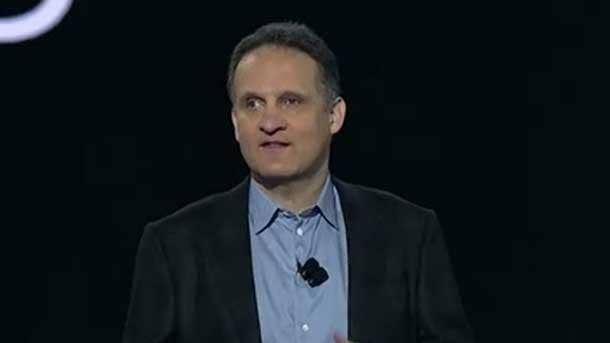
Pitch To Partners On Sustainability
We created this climate pledge 2019, which is a pledge across Amazon to be net carbon zero by 2040, which is 10 years ahead of the Paris Accords.
And we’ve actually already gotten over 200 other companies to sign the climate pledge as well. And that’s what I’ve been involved in, helping to encourage and galvanize.
And there are great members of the partner community who’ve signed up—Accenture, Deloitte, Emphasis, Atos, IBM. I’m sure there are others, I’ll just cap it there. And we’re really grateful. And, by the way, if folks here, if their companies have not signed the climate pledge, we really would love to work with you. … We’re very passionate about really being not only local citizens and national citizens—being part of those communities—but also being really positive contributors to the global community.
So I’d love the partners to sign the climate pledge, would love the partners to help us innovate in how we become more sustainable all across Amazon and how we encourage other countries, nations, companies, individuals to do so as well.
Financial Cloud For Data
Today, I’m really, really excited to announce a collaboration with Goldman Sachs to launch the Goldman Sachs Financial Cloud for Data.
The Goldman Sachs Financial Cloud for Data combines Goldman’s decades of best-in data financial analytics experience with AWS’ industry-leading cloud capabilities. And together we’ll reduce the time and developer resources that investment firms spend managing infrastructure and wrangling data and provide them with advanced analytics capabilities.
With minimal setup, clients can now analyze a range of financial datasets at scale, using the latest quantitative techniques that Goldman Sachs uses to analyze markets in real time and facilitate millions of trades per day.
We’re really excited that this collaboration is going to put exciting new technology in the hands of more funds, asset managers and other institutional clients that power innovation throughout the financial services industry.
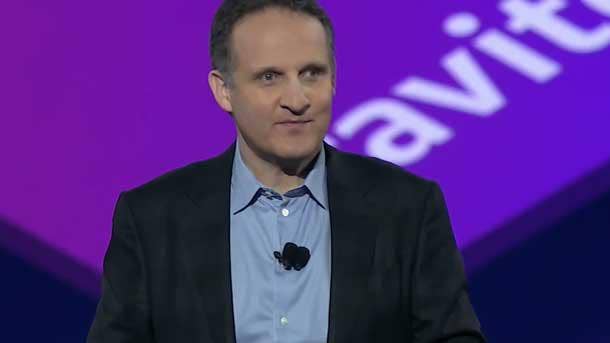
More AWS Industry Offerings A Partner Opportunity
The whole partner ecosystem has been an absolutely foundational part of the AWS strategy since day one. We fully realize we can’t do it alone. Our customers don’t want us to do it alone. And we embrace a full range of ISVs, SaaS providers and systems integrators, etc.
And I think there’ll be a number of partners who will plug into these solutions [such as the Goldman Sachs Financial Cloud for Data]. I suspect we’ll have SIs and consultants who are really talking about building broader solutions around or involving the offering that we’ve announced today.
If customers have SI and consultant relationships and they want to use those as they build out solutions, then we’re going to have great relationships with those companies. That’s our job. And so we’ve already got those relationships in place, and I suspect this will be another important factor that those SIs take out to their customers.
Graviton3 Processor, Expanding SAP Partnership
I’m really pleased to announce Graviton3, the next generation of AWS-designed chips. Graviton3 chips are another big leap forward—25 percent faster on average for general compute workloads than Graviton2. And they perform even better for certain specialized workloads.
They provide two times faster floating-point performance for scientific workloads, are two times faster for cryptographic workloads, and three times faster for ML workloads. And to help reduce carbon footprints, Graviton3 processors use up to 60 percent less energy for the same performance as comparable instances.
We’re incredibly excited for you to get going with Graviton3. So today, we’re also announcing the C7g instance, the first of a new generation of EC2 instances powered by Graviton3.
And you can expect to have fantastic price-performance for compute intensive workloads.
And we’re going to continue to bring more improvements to Graviton3 for your workloads as we deliver more and more instances that are going to be based on Graviton3. … We know we’ll never be done innovating within compute. And we keep working intently with customers and partners in this pursuit.
This includes SAP, which has thousands of customers already running on AWS. And now we’re working with SAP on a new initiative to power the SAP HANA Cloud with AWS Graviton processors. This should deliver significant performance and efficiency improvements for joint customers. We’re excited about it.
So you can see we continue to seek ways to make the cloud even more powerful and more cost-effective for every workload.
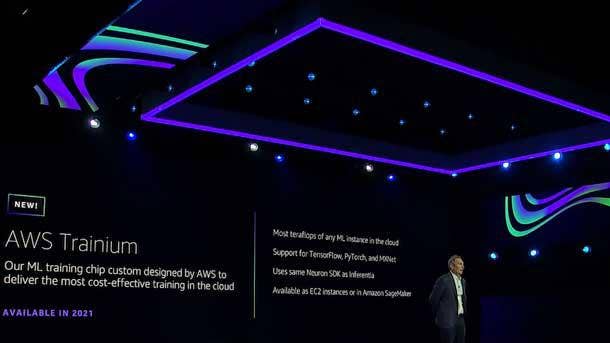
Trn1 Unveiled
Today, I’m excited to announce the new Trn1 instance powered by Trainium, which we expect to have the best price-performance for training deep learning models in the cloud fastest on EC2.
You can use Trn1 to train machine learning models for apps like image recognition, natural language processing, fraud detection and forecasting. Trn1 is the first EC2 instance with up to 800 Gigabit-per-second networking and bandwidth so it’s absolutely great for large-scale, multinode, distributed training cases.
Sometimes with machine learning workloads, you need more processing than any single instance can handle. And we can network these together with what we call UltraClusters, consisting of tens of thousands of Trainium accelerators interconnected with petabit-scale networking.
These Trainium UltraClusters are powered by powerful machine learning supercomputers that are rapidly training the most complex deep learning models with trillions of parameters.
Now with both Trainium and Inferentia-powered instances, customers can have the best price-performance from machine learning—from scaling training workloads to accelerating deep learning workloads in production with high-performance inference.
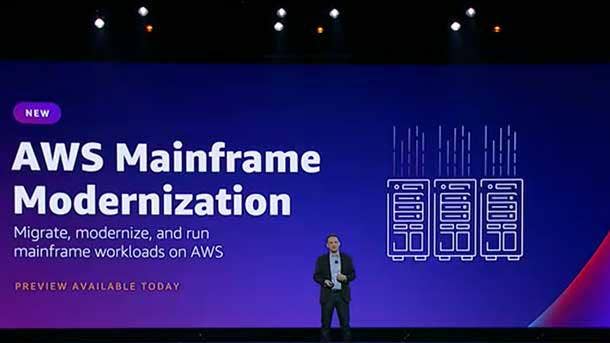
Mainframe Modernization Debuts
Today I’m really pleased to announce AWS Mainframe Modernization, which is a new service to make it faster to migrate, modernize and run mainframe applications on AWS.
With AWS Mainframe Modernization, we’ve seen the time that it takes to move mainframe workloads to the cloud cut by as much as two-thirds using a complete set of development tests and deployment tools and a mainframe-compatible runtime environment.
Mainframe modernization helps you assess, helps you analyze your mainframe application for readiness, choose the path you want—replatform or refactor—and then come up with a plan.
If you want to replatform and move your app over to AWS with minimal code changes, you can use Mainframe Modernization’s re-compilers to convert your code and its testing services to make sure you don’t lose any functionality in the translation. … If you want to refactor or decompose the applications, you can just run the components in EC2, in containers, in [AWS’ serverless, event-driven compute service] Lambda, then our Mainframe Modernization service can actually automatically convert the Cobol code over to Java for you.
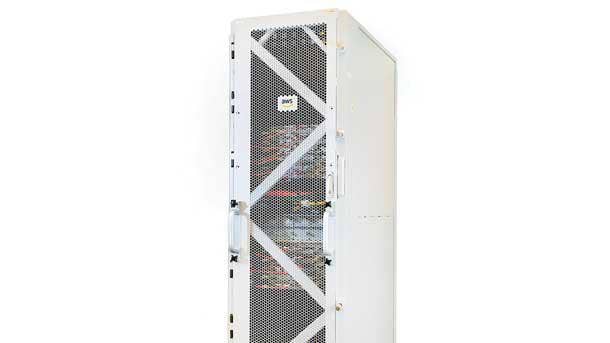
Introducing Smaller Outpost Form Factors
You’ve told us you need AWS in more new places than just your data center. Many of you are running apps in places beyond AWS regions and your data centers. These apps rely heavily on the cloud for processing, analytics, storage and machine learning. And, in fact, many are possible because of the cloud.
But in some cases, they need compute storage locally. The edge of the cloud is pushing outwards to facilities like factories, hospitals, remote locations like oil rigs and agricultural fields and 5G networks.
We’ve been innovating to bring AWS to those places that your applications are increasingly taking you. I think this is going to unleash a wave of innovation.
But you’ve told us that for this to work, the whole thing has to be seamless. …
So where else will you find AWS? Well, we have smaller Outpost form factors [as 1U and 2U rack-mountable servers], which we’re really excited to announce are generally available today. They take up less space, you can bring AWS to offices, to factories, to hospitals.
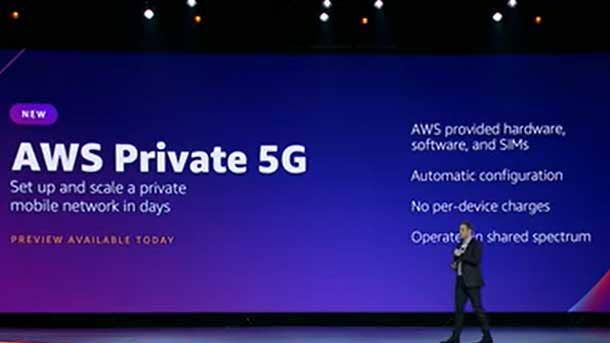
Private 5G Revealed
With 5G you can easily connect tens of thousands of devices. The handoffs between access points are seamless, and you can maintain coverage for large areas, and you get high bandwidth and low latency.
Designing, building, deploying a mobile network takes a lot of time and is a complicated process requiring telecom expertise. Plus, you have to qualify and work with multiple vendors and each has its own pricing models, most of which include a charge for each device, and that adds up when you’re talking about tens of thousands of devices or more. It is not easy.
That’s why I’m really happy to launch AWS Private 5G, which is a new service to make it easy to deploy and manage your own private mobile network.
With AWS Private 5G you can set up and scale a private mobile network in days instead of months. You get all the goodness of mobile technology without the pain of long planning cycles, complex integrations and high endpoint costs. It’s shockingly easy.
You tell us where you want to build your network, specify the network capacity, we ship you all the required hardware, the software and the SIM [subscriber identity module] cards.
Once they are powered on, the Private 5g network just simply auto-configures and sets up the global network that can send anything from your corporate office to a large campus to factory floor or a warehouse. You just pop the SIM cards into your device and voila—everything connected.
Ordering additional capacity. Provisioning additional devices for managing access permissions can be done easily just using the AWS Console.
Best of all, you can provision as many connected devices and users as you want without any per-device charges.
And with Private 5G, it operates with shared spectrum so you don’t even need a spectrum license.
There’s currently nothing like AWS Private 5G out there. A one-stop shop, managed, private cellular network that lets you start small and scale up as you need with pay-as-you-go pricing. And we’re really happy to bring it to you.
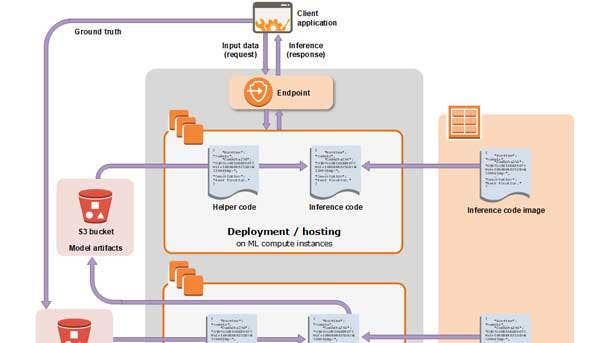
More Data Integrations, Partnerships
Since we launched SageMaker in 2017, we’ve added 150 capabilities and features that we’re not slowing down … tens of thousands of customers are using SageMaker today to train models, billions of parameters, and to make hundreds of billions of predictions every month. … We also continue to build out direct integrations between the various services.
For example, today you can access SageMaker from Redshift, Aurora or Neptune. This means that a Redshift user could write a SQL statement that calls SageMaker behind the scenes to automatically build, train and optimize and bring a model back to Redshift as a function. So you can benefit from SageMaker’s best-in-class ML without ever leaving Redshift.
We’re also enabling integration with a lot of AWS partners. For example, earlier this year, we announced an important expansion of our relationship with Salesforce where you can now automatically see Salesforce data inside of AWS and AWS data inside of Salesforce. It’s really powerful and just an incredibly useful interaction.
The key point again, is that we know your data is on a journey. All stops along the journey matter. You can’t skip any of them. And at each step, we have to have the right capabilities.
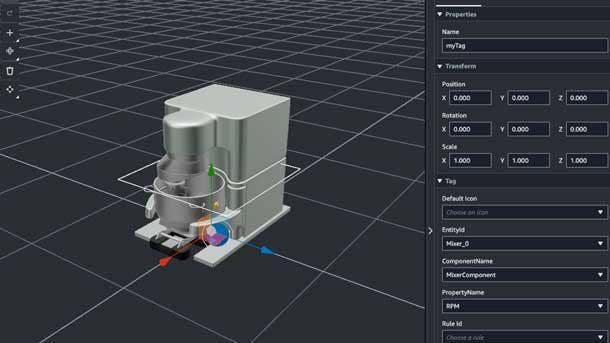
AWS IoT TwinMaker Announced
We wanted to make digital twins available to as many companies as possible. That’s why we’re really pleased to be announcing AWS IoT TwinMaker, a new service to make it easier for developers to create digital twins of real-time systems like buildings, factories, industrial equipment and production lines.
These developers connect IoT TwinMaker to data sources like equipment, sensors, video feeds or business applications.
If you’re already using AWS, many of those connections are built right in. TwinMaker automatically creates a knowledge graph and understands and maps off relationships between the data sources.
So it’s kept up to date in real time as the data changes. Then you import your 3-D models and TwinMaker creates the digital twin, and you’re now ready to use it to understand and improve your physical system.
Customers are really going to innovate faster and operate more efficiently with this new capability.
We’re also collaborating with Siemens to include TwinMaker along with 60 other AWS services and their industrial solutions offerings. Working together, we’re making it easier for companies of any size to use digital twins in their business.
Selipsky Presents IoT FleetWise
The advanced vehicle sensors on one car can generate up to 2 terabytes of data every hour. Two terabytes. Now multiply that by an ever-increasing number of vehicle makes and models all generating data in different formats. It’s easy to understand why it’s necessary to build custom data collection systems.
But building these systems is difficult. Time-consuming. That’s why today we’re announcing AWS IoT FleetWise, which is a new service that makes it easier and more cost-effective for automakers to collect, to transform and to transfer vehicle data in the cloud in near-real-time.
Automakers can use IoT FleetWise to easily collect and standardize vast amounts of data from millions of vehicles.
IoT FleetWise can then send this data for processing in near-real-time by applying intelligent filtering capabilities to sift through petabytes of connected vehicle data to extract only what’s needed. That drastically reduces the volume of data being transferred.
Once the data is in AWS, automakers can perform remote diagnostics. They can analyze fleet health, prevent safety issues or improve autonomous driving systems.
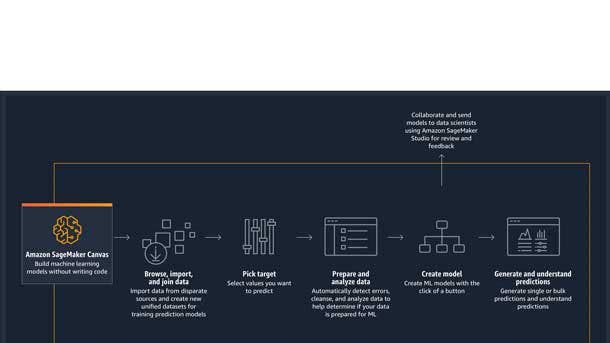
AWS Sagemaker Canvas
[Business analysts] are asking for more powerful capabilities so they can quickly make more precise predictions and apply machine learning to a range of problems like reducing churn, detecting fraud, forecasting sales or optimizing inventory.
But most analysts don’t have the skills to do this today. If you look back a few years, in fact, only a very small number of experts in machine learning actually had the skills to do this. So we built Amazon SageMaker as a way to democratize machine learning. And the momentum we’re seeing around SageMaker is really exciting.
So we asked ourselves whether there was something we could do to further democratize ML by helping an entirely new group of users with no ML experience, no data science experience, who are not even developers, to be able to do machine learning.
Today I’m excited to announce a new capability of SageMaker to enable business users and analysts to generate highly accurate machine learning predictions using a visual point-and-click interface with no coding required—Amazon SageMaker Canvas.
Now business users and analysts can use Canvas to generate highly accurate predictions using an intuitive, easy-to-use interface without writing code and no ML experience.
Canvas uses terminology and visualizations that are already familiar to analysts and complements the data analysis tools that they’re already using.
With Canvas you can browse and access petabytes of data from both cloud and on-premises data sources, such as Amazon S3, Redshift, RDS [Amazon Relational Database Service] and your own local files.
Canvas uses powerful automated machine learning technology to create models that enable business users and analysts to create predictions of the same high quality as data scientists.
Once the models are created, users can easily publish results, explain and interpret models and share dashboards and those models between other analysts and collaborate and enrich insights.
With Canvas we are making it even easier to prepare and gather data from machine learning to train models faster and expand machine learning to an even broader audience. It’s really going to enable a whole new group of users to leverage their data and to use ML to create new business insights.

Cloud Changes Culture
Ultimately, what the cloud and AWS offer is the opportunity to truly transform.
CEOs and other leaders tell me all the time that the move to the cloud is reshaping their culture.
It’s allowing them to harness their data in new ways and drive better decisions. It’s freeing up resources, removing obstacles out of the way to make innovation faster, easier and better. … Despite everything we’ve done over the past 15 years, we’re still only getting started with this transformation promise.
In the future, the cloud will empower even more people to innovate, create new businesses and solve the world’s most pressing challenges.
All of us will have the opportunity to find a better way or to see what others didn’t. And along the way, we’ll find the opportunity to enable others to forge their own paths.
With that as our destination, our promise is that we will continue to keep our customers’ needs at the center of everything we do.
We’ll continue making AWS more powerful with foundational capabilities, more intelligent with data and ML insights and easier to use for targeted functional and industry use cases.
We’ll continue to improve performance and security, drive down cost and enable more innovation. And we will continue to push the edge of the cloud, to put it into the hands of anyone who wants to use it.
When we say the cloud’s become a movement, it’s actually even more than that. The cloud is an opportunity to reimagine everything and provides a pathway to true transformation.